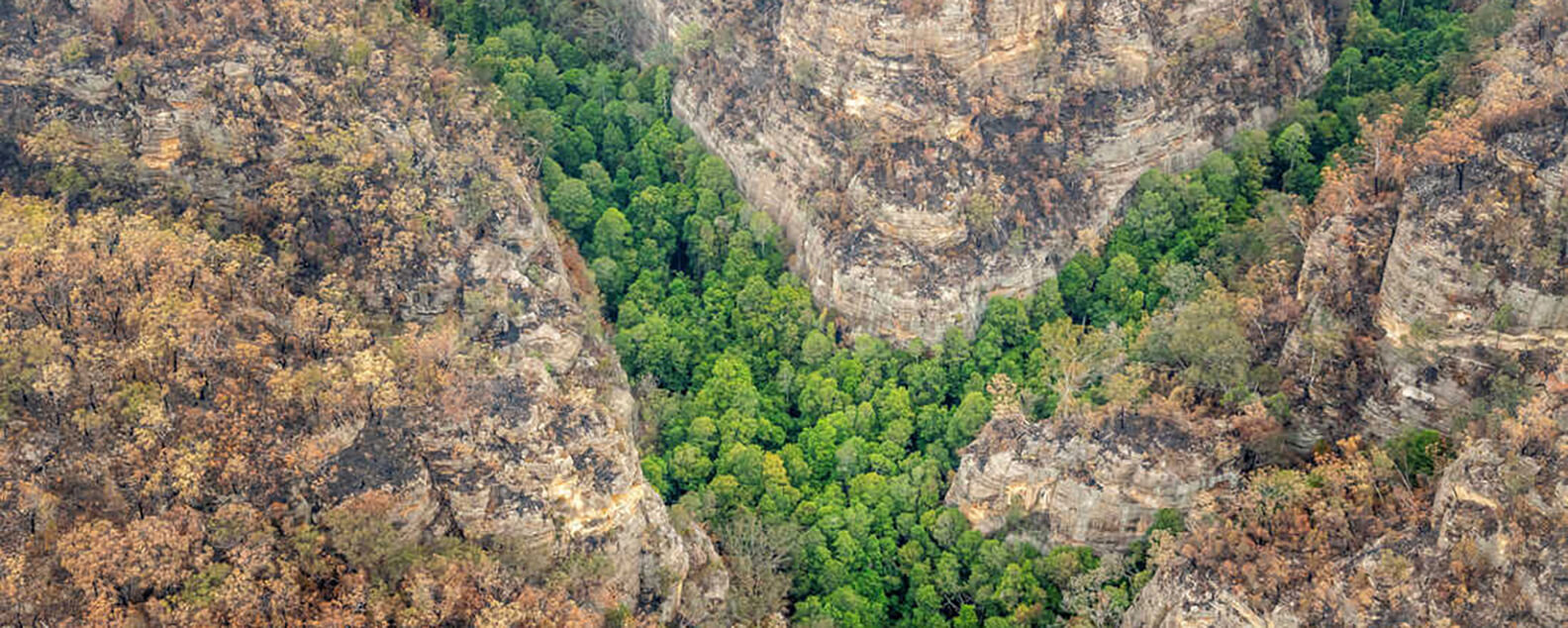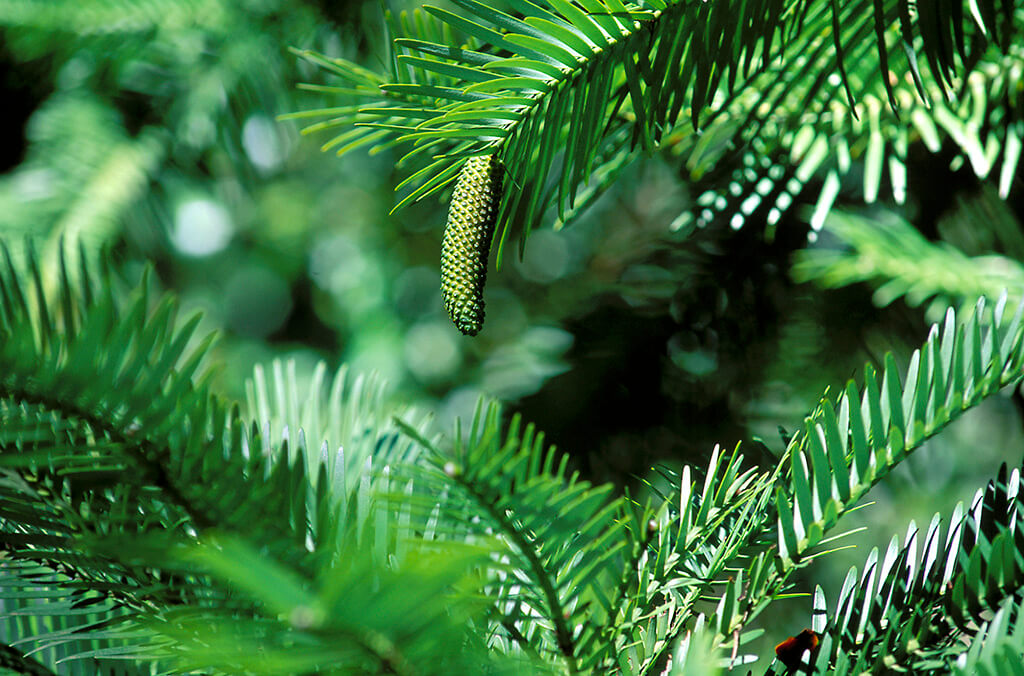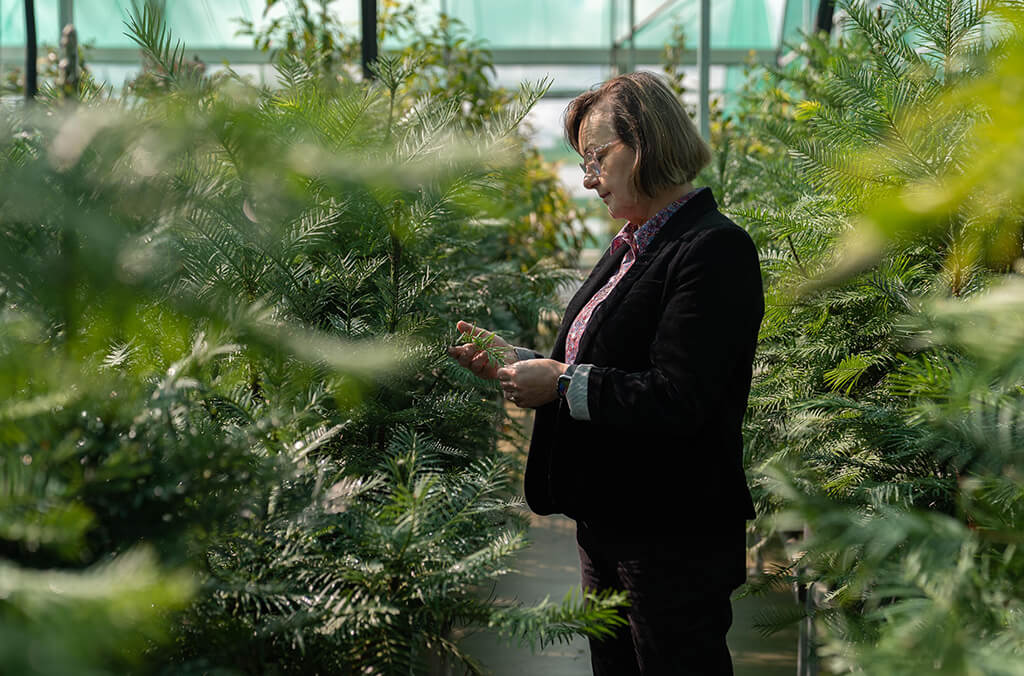The global endeavour to save Australia’s iconic ‘dinosaur tree’
Distributing genetically diverse Wollemi Pines around the world is setting a new benchmark for conservation.

Hundreds of young Wollemi Pines have been sent to international botanic gardens to help save the species and pave the way for protecting other endangered plants.
The discovery of a living fossil
Deep within a remote canyon in the Blue Mountains about 150 kilometres north-west of Sydney, there are a small grove of secret survivors. Towering up to 40 metres tall with bubbly brown bark and deep-green needles and cones, the bristly wonders were presumed extinct for 60 million years until 1994.
David Noble, an off-duty National Parks and Wildlife Service ranger, was greeted by this stand of unfamiliar giants while canyoning. He brought specimens to scientists at the Royal Botanic Garden Sydney who identified it as a new species: Wollemia nobilis, the Wollemi Pine. Incredibly, they found its lineage dated back hundreds of millions of years and its DNA was so unique it was classified in its own genus, therein becoming one of the rarest and oldest trees in the world.
The discovery was hailed as one of the great botanical reincarnations of the century and made international headlines. Unfortunately, there are fewer than 100 trees growing in the wild. A team of ecologists, national parks staff and horticultural scientists were assembled to bring the trees into cultivation to help save it from extinction.
Head of Australian PlantBank Research at Botanic Gardens of Sydney, Dr Cathy Offord, has been dedicated to understanding and saving the Wollemi Pine since its discovery.
“After the discovery, there were so many requests for seeds. But we couldn’t provide them as few seeds were available, they were extremely difficult to collect, and we knew nothing about how to propagate it from cuttings. It’s been a journey of discovery,” Dr Offord said.
After years of research, The Wollemi Pine was finally made available to the public in 2005, and from there, their popularity exploded. This curious conifer has captured the hearts and minds of people around the world and can now be found thriving in parks, gardens and backyards across the globe.

Wollemi Pines are one of the rarest and oldest trees in the world. Credit: Botanic Gardens of Sydney.
Battling bushfires
Armed with an understanding of how to grow the Wollemi Pine, scientists and horticulturists now turned to DNA technology to create a back-up collection of the species in the nursery at the Australian Botanic Garden Mount Annan, which represents the full range of its known diversity in the wild.
Along with new diseases and illegal harvesting - fire is a major threat to the Wollemi Pine in the wild. The Black Summer fires in 2019/2020 reached the Wollemi National Park and airborne tankers and firefighters just managed to stop the wild population from completely burning down.
As the climate continues to warm, the development of additional back-up collections of genetically diverse and globally dispersed Wollemi Pines is crucial to help increase the survival chances of this critically endangered species.
“When the Wollemi Pine was discovered, there were fewer than 100 species left in the wild. The Black Summer fires burned some of the wild population and now there are even less. The global meta-collection project will create additional insurance populations to help guarantee its survival,” said Dr Cathy Offord.

Head of Australian PlantBank Research at Botanic Gardens of Sydney, Dr Cathy Offord, inspects the collection of Wollemi Pines inside the nursery at the Australian Botanic Garden Mount Annan. Credit: Botanic Gardens of Sydney.
Decades of research supports new global meta-collection project
The new Wollemi Pine meta-collection project is a global collaborative effort with key partners Botanic Gardens Conservation International and Forestry England, and other global participating botanic gardens. It is informed by decades of research, including a recent citizen science survey developed by Dr Offord and Dr Heidi Zimmer from CSIRO.
The I Spy A Wollemi Pine survey was launched in 2019 to help scientists understand more about the best growing conditions and tolerances of the tree around the world. The survey received over 1,500 responses and revealed Wollemi Pines are growing everywhere from Hawaii to Moscow - thriving in loamy soil, with a temperate climate between 3.2 and 25.4C and above-average rainfall.
“Our survey was vital in gaining as much knowledge as possible and provides crucial data around the growing conditions of Wollemi Pines to inform the long-awaited global meta-collection project,” said Dr Offord.
For the first phase of the project, more than 210 young Wollemi Pines representing the full diversity of the wild population have been shipped to carefully selected botanic gardens in the United Kingdom, Ireland, Europe, Australia and North America.
“This project is the culmination of almost 30 years of scientific research to understand everything about these trees, from growing them right through to diseases that impact it,” said Dr Offord.
John Siemon, Director of Horticulture & Living Collections at Botanic Gardens of Sydney, said the international botanic gardens have been carefully selected for their climatic suitability.
“Each botanic garden we’re sending the Wollemi Pines to has been strategically selected to provide the best possible long-term conditions for a resilient and globally distributed meta-collection,” John said.
“We’ve sent them a micro-population of six individual plants, to ensure there’s plenty of genetic diversity in their living collection. This will protect the trees for future generations and increase the chances of healthy, long living specimens,” said John.
“Every Garden will have a different approach for growing them, some will grow in conservatories, some will be planted in the ground and hopefully they will live for hundreds of years.”
“The Wollemi Pine has become an icon and it’s now a role model for how we can approach conservation efforts for saving other critically endangered species," said John Siemon.

Wollemi Pines arrive at Bedgebury National Pinetum. Credit: Bedgebury National Pinetum
Planting the seed for future conservation projects
The Wollemi Pine meta-collection project showcases the possibilities of global collaboration to conserve plant species. With 45% of flowering plants around the world at risk of extinction, scientists at Botanic Gardens of Sydney aim to see more critically endangered plants protected in the future.
Chief Executive of Botanic Gardens of Sydney, Denise Ora, said the ambitious project builds on 200 years of innovation at Botanic Gardens of Sydney to safeguard Australia’s unique plant life.
“Three decades ago, the world was captured by the extraordinary finding of the Wollemi Pine, and we’ve been at the forefront of safeguarding its survival since through a range of innovative conservation solutions,” Ms Ora said.
“This global collaboration reflects decades of hard work by our scientists and horticulturists who have pioneered the project. With so many other Australian plant species critically endangered, this is just the beginning for protecting our most beloved species,” said Ms Ora.
The meta-collection will lead conservation efforts for other critically endangered plant species.